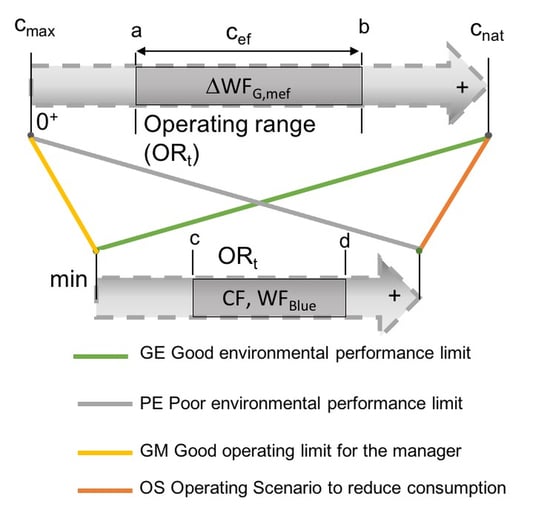Wastewater Treatment Plant Assessment by Quantifying the Carbon and Water Footprint
Abstract
1. Introduction
2. Proposed Methodology
2.1. Water Footprint Assessment in WWTPs
2.1.1. Blue Water Footprint as a Consumption Indicator
2.1.2. Grey Water Footprint as an Efficiency Indicator
2.2. Carbon Footprint Assessment in WWTP
2.3. Joint Assessment of WF and CF in WWTP
3. WWTPs Data Inventory
4. Results and Discussion
4.1. WF Assessment
4.2. CF Assessment
4.3. WFR and CFR Analysis
5. Conclusions
- The operation and exploitation of WWTPs cause environmental impact, which is quantified by WFBlue, at 0.78 m3 per cubic metre of water treated on average, and CF, at 0.28 kg CO2/m3 for the four WWTPs. However, WWTPs have a positive impact on the environment; the reduction in the pollution load in the discharge as indicated by ∆WFG,mef is better than the strict reduction established by the regulations in the four WWTPs in the period studied.
- In the four WWTPs, the values of ∆WFG,mef revealed a high operational margin in the elimination of BOD5. Instead, there is a lower operational range of the total nitrogen and total phosphorous pollutant parameters. For example, BOD5 ∆WFG,mef at Cuacos was 9.41 m3 per cubic metre of water treated in 2014, compared to ∆WFG,mef values of 2.42 and 6.62 m3 per cubic metre cubic of water treated for TN and TP, respectively.
- The proposed WFR and CFR ratios indicate optimal operational scenarios from an environmental or managerial point of view. The highest values of WFR and CFR for TN and TP belong to the best scenario for the environment. In cases where better operation of the WWTP is observed, according to the manager, the tendency is to generate intermediate values of WFR and CFR for TN and TP.
- Poor environmental scenarios, taking into account the criteria of managers, show the lowest rates of WFR and CFR for TN and TP in the period of time analysed.
- Regarding BOD5, the highest WFR and CFR values are found in a scenario where the possibility of decreasing the environmental impact in correlation with the allowed reduction in the operation range was investigated. In the four WWTPs studied, this scenario happened in 2015.
Author Contributions
Funding
Acknowledgments
Conflicts of Interest
Abbreviations
| BOD5 | Biochemical oxygen demand at five days |
| cef | Concentration of respective pollutant measured in WWTP effluent |
| cmax | Concentration of respective pollutant allowed by the standard |
| cnat | Concentration of respective pollutant measured in receiving body of water |
| cr | Concentration of the respective pollutant measured in WWTP influent |
| CF | Carbon footprint |
| CFR | Carbon footprint ratio |
| CH4 | Methane |
| EP | Equivalent population |
| GE | Good environmental performance limit |
| GHG | Greenhouse gas emissions |
| GM | Good managerial performance limit |
| IPCC | Intergovernmental Panel on Climate Change |
| N2O | Nitrous oxide |
| OS | Operational Scenario |
| PE | Poor environmental performance limit |
| Qr | Influent volume per unit of time |
| TN | Total nitrogen |
| TP | Total phosphorus |
| VolumeEvap | Volume of water evaporated per unit of time |
| VolumeSludge | Volume of freshwater incorporated into sludge per unit of time |
| WF | Water footprint |
| WFBlue | Blue water footprint |
| WFElect | Blue water footprint due to electricity consumption |
| WFChem | Blue water footprint due to chemical consumption |
| WFGreen | Green water footprint |
| WFGrey | Grey water footprint |
| ∆WFG,mef | Operational grey water footprint |
| WFD | Water framework directive (Directive 2000/60/EC) |
| WFR | Water footprint ratio |
| WWTP | Wastewater treatment plant |
| Cuacos WWTP | Located in Aldeanueva de la Vera and Cuacos de Yuste |
| Tejeda WWTP | Located in Arroyomolinos, Pasarón de la Vera and Tejeda de Tiétar |
| Villanueva WWTP | Located in Villanueva de la Vera and Valverde de la Vera |
| Torremenga WWTP | Located in Torremenga |
References
- Ansorge, L.; Čejka, E.; Dlabal, J.; Stejskalová, L. Effect of wastewater treatment plants to the reduction of pollution discharged in the Czech part of the Odra river basin. Sci. Rev. Eng. Environ. Sci. 2020, 29, 123–135. [Google Scholar] [CrossRef]
- Galli, A.; Wiedmann, T.; Ercin, E.; Knoblauch, D.; Ewing, B.; Giljum, S. Integrating Ecological, Carbon and Water footprint into a “Footprint Family” of indicators: Definition and role in tracking human pressure on the planet. Ecol. Indic. 2012, 16, 100–112. [Google Scholar] [CrossRef]
- Guerrini, A.; Romano, G.; Ferretti, S.; Fibbi, D.; Daddi, D. A Performance Measurement Tool Leading Wastewater Treatment Plants toward Economic Efficiency and Sustainability. Sustainability 2016, 8, 1250. [Google Scholar] [CrossRef]
- Teodosiu, C.; Barjoveanu, G.; Sluser, B.R.; Popa, S.A.E.; Trofin, O. Environmental assessment of municipal wastewater discharges: A comparative study of evaluation methods. Int. J. Life Cycle Assess. 2016, 21, 395–411. [Google Scholar] [CrossRef]
- Chen, K.-H.; Wang, H.-C.; Han, J.-L.; Liu, W.-Z.; Cheng, H.-Y.; Liang, B.; Wang, A.-J. The application of footprints for assessing the sustainability of wastewater treatment plants: A review. J. Clean. Prod. 2020, 277, 124053. [Google Scholar] [CrossRef]
- Hoekstra, A.Y. Virtual Water Trade. Proceedings of the International Expert Meeting on Virtual Water Trade; Value of Water; IHE: Delft, The Netherlands, 2003. [Google Scholar]
- Hoekstra, A.Y.; Chapagain, A.K.; Aldaya, M.M.; Mekonnen, M.M. The Water Footprint Assessment Manual: Setting the Global Standard; Earthscan: London, UK, 2011. [Google Scholar]
- AENOR UNE-EN ISO 14046. Gestión ambiental. Huella de agua. Principios, requisitos y directrices; AENOR: Madrid, Spain, 2015. [Google Scholar]
- Ansorge, L.; Beránková, T. LCA Water Footprint Aware Characterization Factor Based on Local Specific Conditions. Eur. J. Sustain. Dev. 2017, 6, 13–20. [Google Scholar] [CrossRef]
- Boulay, A.-M.; Lenoir, L.; Manzardo, A. Bridging the Data Gap in the Water Scarcity Footprint by Using Crop-Specific AWARE Factors. Water 2019, 11, 2634. [Google Scholar] [CrossRef]
- AENOR UNE-EN ISO 14040. Gestión ambiental. Análisis ciclo de vida. Principios y marco de referencia; AENOR: Madrid, Spain, 2006. [Google Scholar]
- AENOR UNE-EN ISO 14044. Gestión ambiental. Análisis ciclo de vida. Requisitos y directrices; AENOR: Madrid, Spain, 2006. [Google Scholar]
- Boulay, A.-M.; Hoekstra, A.Y.; Vionnet, S. Complementarities of Water-Focused Life Cycle Assessment and Water Footprint Assessment. Environ. Sci. Technol. 2013, 47, 11926–11927. [Google Scholar] [CrossRef]
- Zhang, G.P.; Hoekstra, A.Y.; Mathews, R. Water Footprint Assessment (WFA) for better water governance and sustainable development. Water Resour. Ind. 2013, 1, 1–6. [Google Scholar] [CrossRef]
- Li, H.; Liu, G.; Yang, Z. Improved gray water footprint calculation method based on a mass-balance model and on fuzzy synthetic evaluation. J. Clean. Prod. 2019, 219, 377–390. [Google Scholar] [CrossRef]
- Romeiko, X.X. Comprehensive water footprint assessment of conventional and four alternative resource recovery based wastewater service options. Resour. Conserv. Recycl. 2019, 151, 104458. [Google Scholar] [CrossRef]
- Morera, S.; Corominas, L.; Poch, M.; Aldaya, M.; Comas, J. Water footprint assessment in wastewater treatment plants. J. Clean. Prod. 2016, 112, 4741–4748. [Google Scholar] [CrossRef]
- Gu, Y.; Dong, Y.-N.; Wang, H.; Keller, A.; Xu, J.; Chiramba, T.; Li, F. Quantification of the water, energy and carbon footprints of wastewater treatment plants in China considering a water–energy nexus perspective. Ecol. Indic. 2016, 60, 402–409. [Google Scholar] [CrossRef]
- Gómez-Llanos, E.; Durán-Barroso, P.; Matías-Sánchez, A. Management effectiveness assessment in wastewater treatment plants through a new water footprint indicator. J. Clean. Prod. 2018, 198, 463–471. [Google Scholar] [CrossRef]
- Risch, E.; Loubet, P.; Núñez, M.; Roux, P. How environmentally significant is water consumption during wastewater treatment?: Application of recent developments in LCA to WWT technologies used at 3 contrasted geographical locations. Water Res. 2014, 57, 20–30. [Google Scholar] [CrossRef]
- Hospido, A.; Moreira, M.T.; Fernández-Couto, M.; Feijoo, G. Environmental performance of a municipal wastewater treatment plant. Int. J. Life Cycle Assess. 2004, 9, 261–271. [Google Scholar] [CrossRef]
- Hospido, A.; Moreira, M.T.; Feijoo, G. A comparison of municipal wastewater treatment plants for big centres of population in Galicia (Spain). Int. J. Life Cycle Assess. 2007, 13, 57–64. [Google Scholar] [CrossRef]
- De Benedetto, L.; Klemeš, J. The Environmental Performance Strategy Map: An integrated LCA approach to support the strategic decision-making process. J. Clean. Prod. 2009, 17, 900–906. [Google Scholar] [CrossRef]
- Lorenzo-Toja, Y.; Vázquez-Rowe, I.; Amores, M.J.; Termes-Rifé, M.; Marín-Navarro, D.; Moreira, M.T.; Feijoo, G. Benchmarking wastewater treatment plants under an eco-efficiency perspective. Sci. Total. Environ. 2016, 468–479. [Google Scholar] [CrossRef]
- Corominas, L.; Foley, J.; Guest, J.S.; Hospido, A.; Larsen, H.F.; Morera, S.; Shaw, A.R. Life cycle assessment applied to wastewater treatment: State of the art. Water Res. 2013, 47, 5480–5492. [Google Scholar] [CrossRef]
- Martínez-Alcalá, I.; Pellicer-Martínez, F.; Fernández-López, C. Pharmaceutical grey water footprint: Accounting, influence of wastewater treatment plants and implications of the reuse. Water Res. 2018, 135, 278–287. [Google Scholar] [CrossRef] [PubMed]
- Penman, H.L. Natural evaporation from open water, bare soil and grass. In Proceedings of the Proceedings of the Royal Society of London A: Mathematical, Physical and Engineering Sciences; The Royal Society: London, UK, 1948; Volume 193, pp. 120–145. [Google Scholar]
- IPCC. Directrices del IPCC de 2006 para los Inventarios Nacionales de Gases de Efecto Invernadero. Desechos; IGES: Hayama, Japón, 2016; Volume 5, ISBN 92-9169-320-0.
- Ministerio para Transición Ecológica y el Reto Demográfico. Factores de emisión registro de huella de carbono, compensación y proyectos de absorción de dióxido de carbono; Ministerio para Transición Ecológica y el Reto Demográfico: Madrid, Spain, 2020.
- Ecoinvent. Available online: https://www.ecoinvent.org/ (accessed on 18 October 2020).
- Parravicini, V.; Svardal, K.; Krampe, J. Greenhouse Gas Emissions from Wastewater Treatment Plants. Energy Procedia 2016, 97, 246–253. [Google Scholar] [CrossRef]
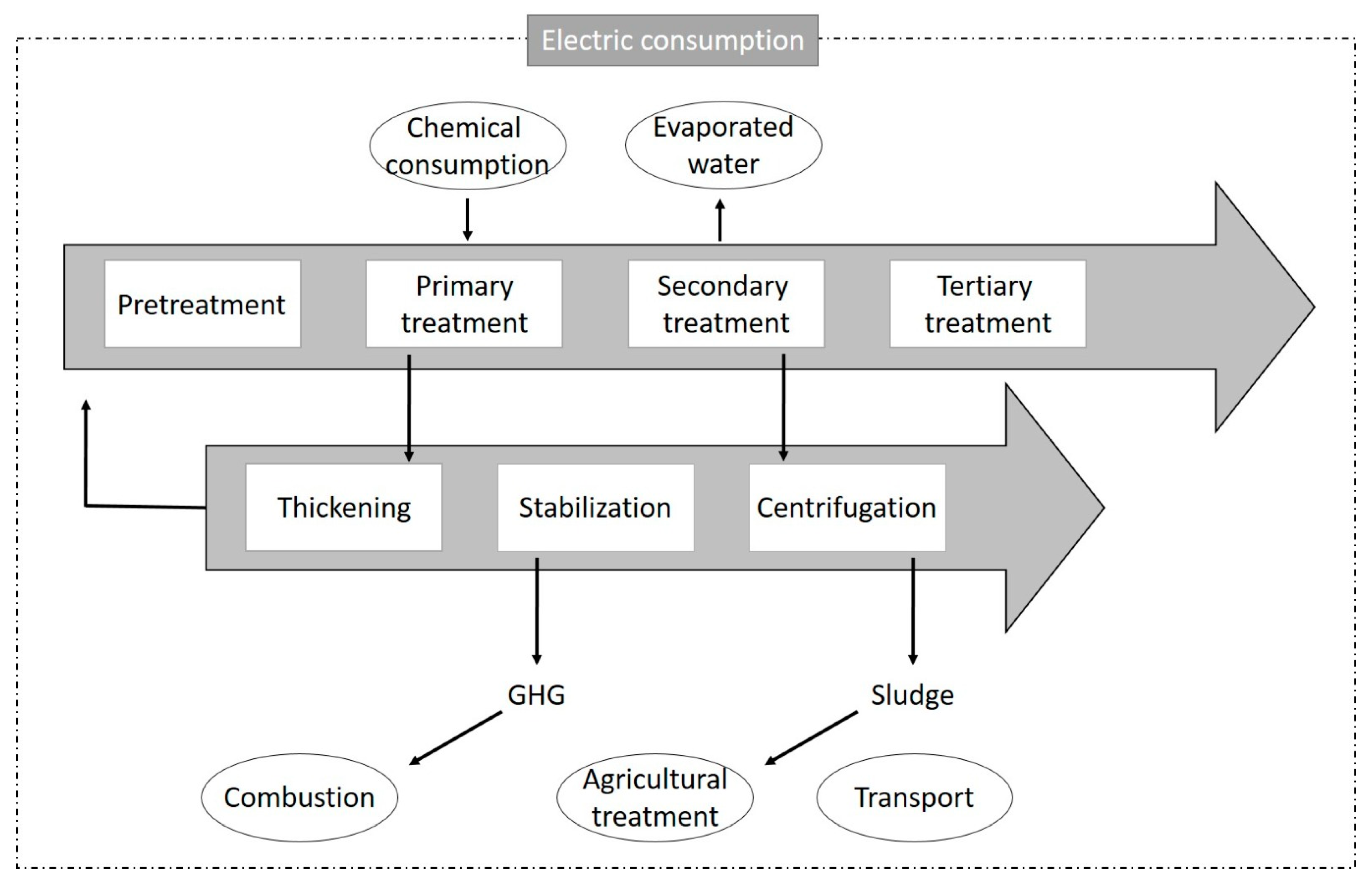

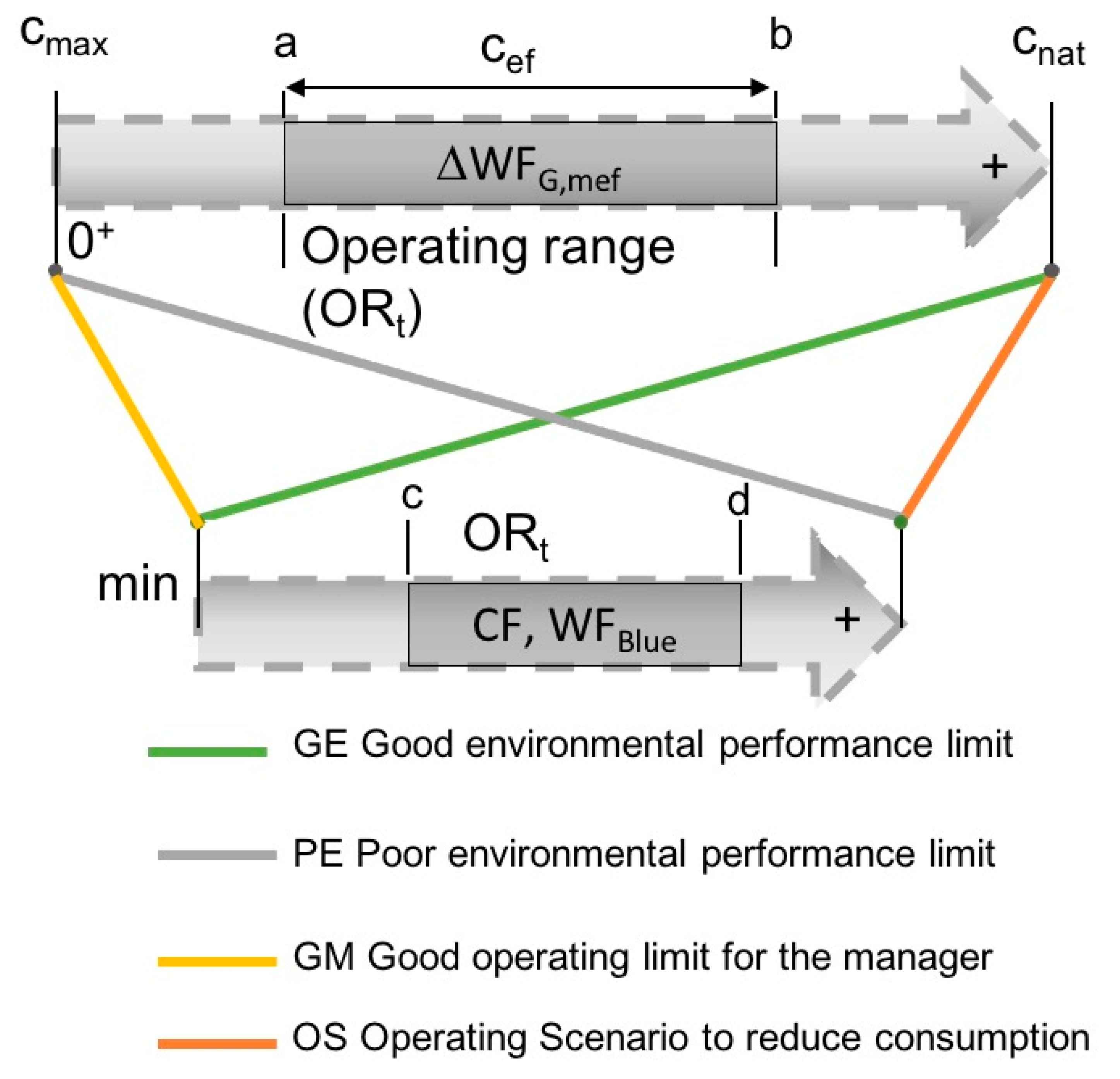
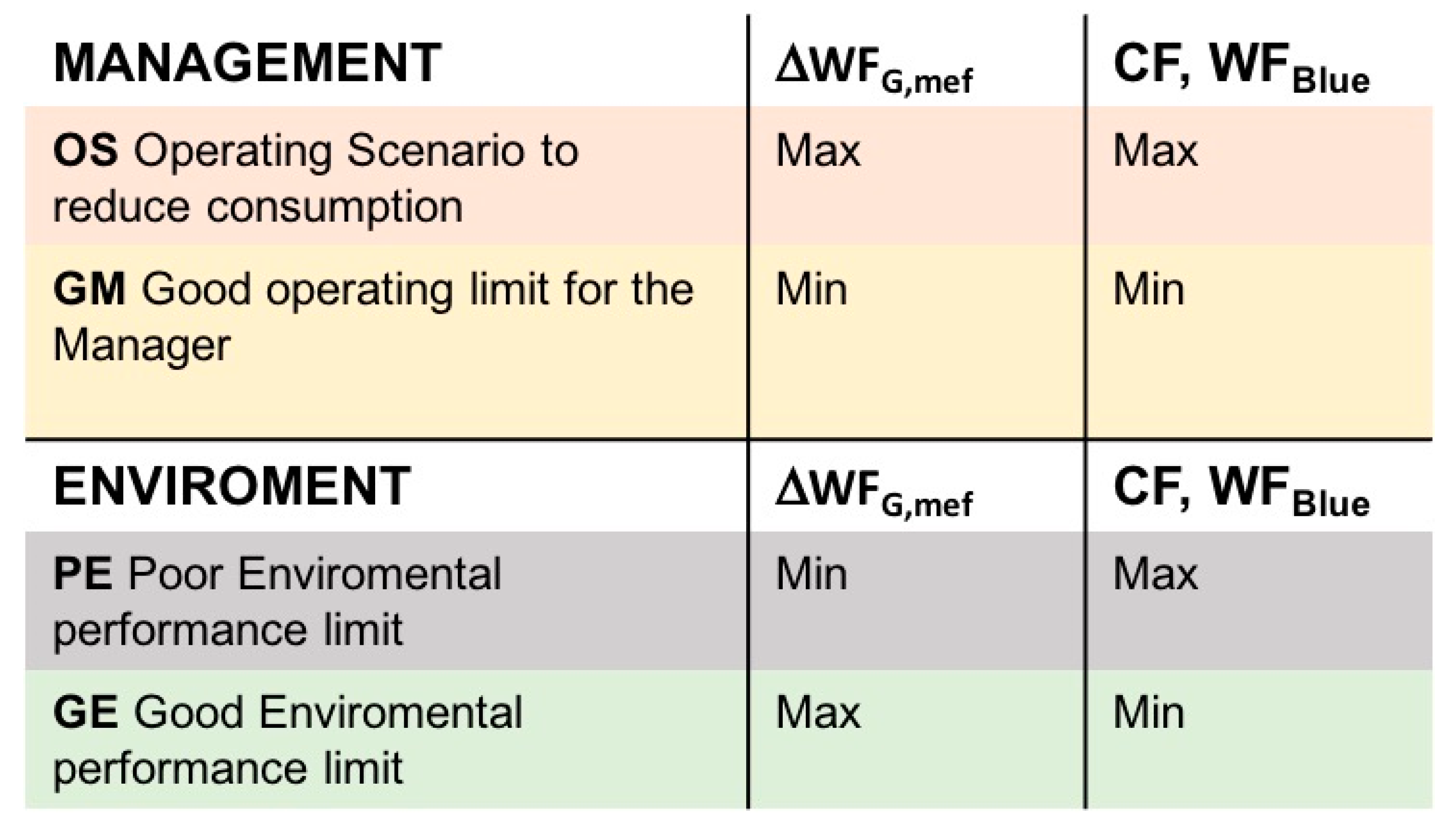
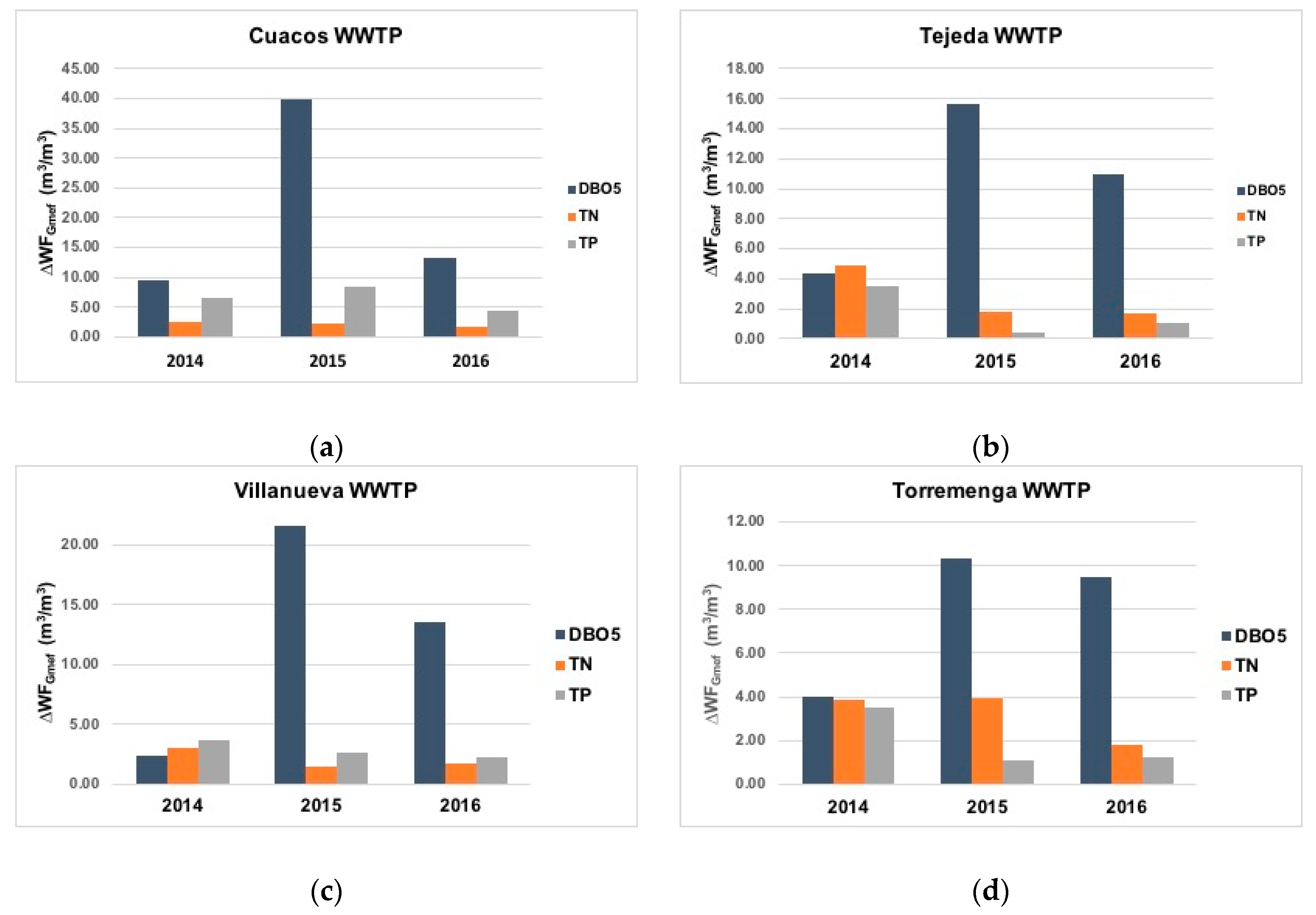
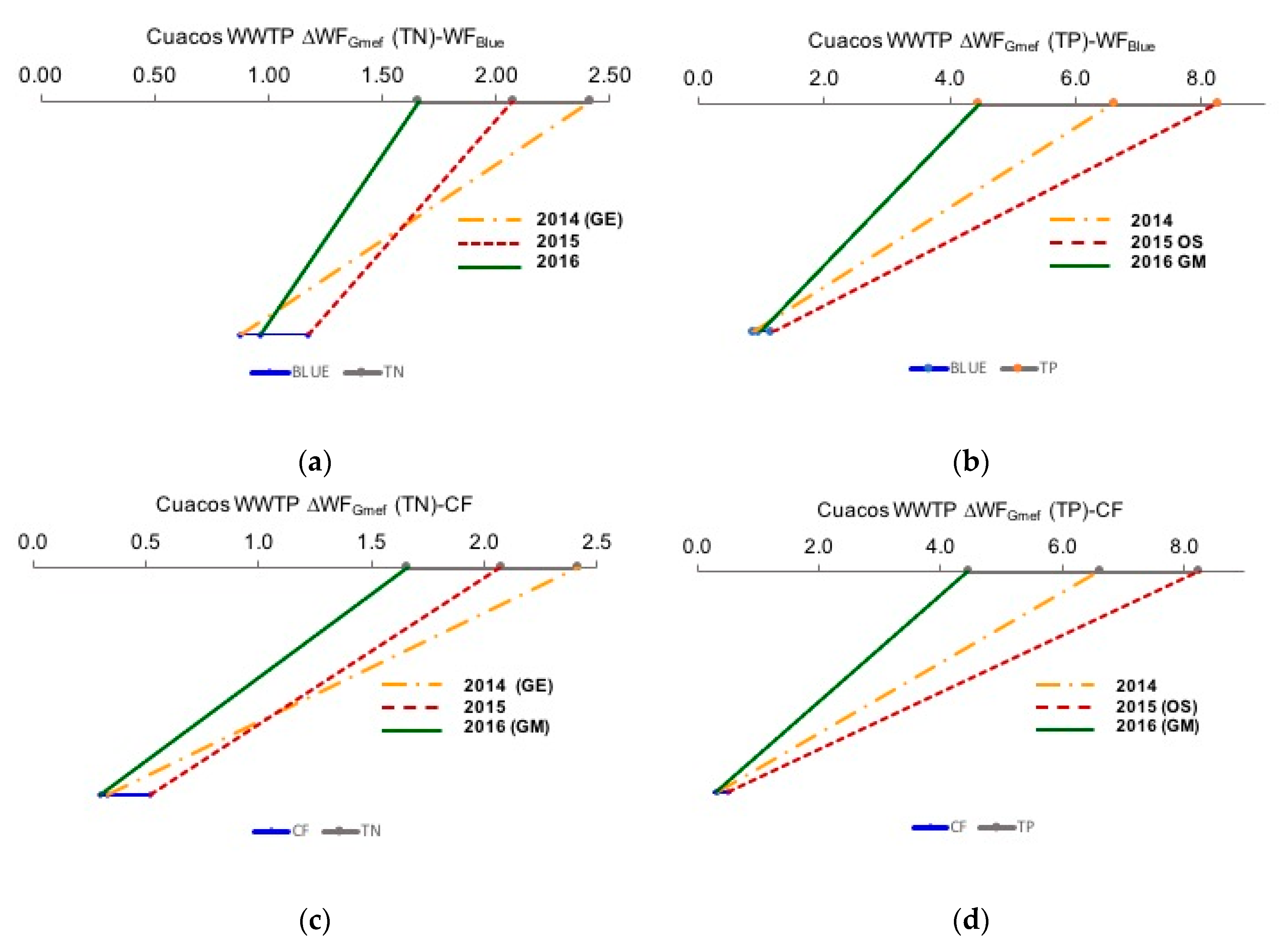
| Emission Source | Necessary Data | References |
|---|---|---|
| Direct | ||
| CH4 | BOD5 (mg/L) Wastewater volume (m3) | Intergovernmental Panel on Climate Change (IPCC) [28] |
| N2O | TN (mg/L) Wastewater volume (m3) | Intergovernmental Panel on Climate Change (IPCC) [28] |
| Indirect | ||
| Electricity consumption | Power consumption (kWh/month) | Spanish Ministry for the Ecological Transition and the Demographic Challenge, 2014 [29] |
| Sludge treatment | Sludge mass (kg) Transport (km) Type of treatment: Agriculture | ECOINVENT 3.0 (2014) [30] from Parrivicini et al. [31] |
| WWTP | Location | Equivalent Population (EP) | Qr (m3/month) | Electricity Consumption (kW/month) |
|---|---|---|---|---|
| Cuacos | 40°06′00.8″ N 5°42′56.9″ W | 8282 | 59,877.39 | 20,641.61 |
| Tejeda | 40°00′35.9″ N 5°52′17.2″ W | 5988 | 36,367.98 | 7342.04 |
| Villanueva | 40°06′32.9″ N 5°27′42.5″ W | 8442 | 49,964.33 | 9662.43 |
| Torremenga | 40°02′30.8″ N 5°46′21.8″ W | 933 | 12,975.24 | 4194.36 |
| WWTP | cr (mg/L) | cef (mg/L) | ||||
|---|---|---|---|---|---|---|
| BOD5 | TN | TP | BOD5 | TN | TP | |
| Cuacos | 217.3 | 49.8 | 3.6 | 9.5 | 9.7 | 0.74 |
| Tejeda | 106.0 | 23.9 | 2.1 | 8.2 | 7.5 | 0.98 |
| Villanueva | 161.0 | 24.0 | 3.0 | 6.0 | 9.0 | 1.00 |
| Torremenga | 103.6 | 24.4 | 2.8 | 9.4 | 7.4 | 0.87 |
| cmax (mg/L) | ||||||
| BOD5 | TN | TP | ||||
| 25 | 15 | 2 | ||||
| WWTP | WFBlue/Q (m3/m3) | ||
|---|---|---|---|
| 2014 | 2015 | 2016 | |
| Cuacos | 0.88 | 1.17 | 0.97 |
| Tejeda | 0.57 | 0.68 | 0.51 |
| Villanueva | 0.55 | 0.68 | 0.48 |
| Torremenga | 0.89 | 1.37 | 0.67 |
| WWTP | CF/Q (kg CO2/m3) | ||
|---|---|---|---|
| 2014 | 2015 | 2016 | |
| Cuacos | 0.33 | 0.52 | 0.33 |
| Tejeda | 0.19 | 0.24 | 0.22 |
| Villanueva | 0.24 | 0.31 | 0.25 |
| Torremenga | 0.26 | 0.29 | 0.22 |
| Cuacos | WFR | Tejeda | WFR | ||||
| BOD5 | TN | TP | BOD5 | TN | TP | ||
| 2014 | 10.75 | 2.76 | 7.56 | 2014 | 7.73 | 8.58 | 6.12 |
| 2015 | 34.10 | 1.77 | 7.05 | 2015 | 22.97 | 2.69 | 0.54 |
| 2016 | 13.81 | 1.72 | 4.62 | 2016 | 21.51 | 3.21 | 2.15 |
| Cuacos | CFR | Tejeda | CFR | ||||
| BOD5 | TN | TP | BOD5 | TN | TP | ||
| 2014 | 28.69 | 7.38 | 20.18 | 2014 | 22.81 | 25.33 | 18.08 |
| 2015 | 77.09 | 4.01 | 15.95 | 2015 | 64.69 | 7.57 | 1.51 |
| 2016 | 44.10 | 5.49 | 14.74 | 2016 | 49.66 | 7.41 | 4.96 |
| Villanueva | WFR | Torremenga | WFR | ||||
| BOD5 | TN | TP | BOD5 | TN | TP | ||
| 2014 | 4.37 | 5.50 | 6.60 | 2014 | 4.46 | 4.35 | 3.90 |
| 2015 | 31.40 | 2.06 | 3.73 | 2015 | 7.53 | 2.86 | 0.80 |
| 2016 | 28.15 | 3.55 | 4.52 | 2016 | 14.17 | 2.72 | 1.88 |
| Villanueva | CFR | Torremenga | CFR | ||||
| BOD5 | TN | TP | BOD5 | TP | TP | ||
| 2014 | 9.74 | 12.28 | 14.71 | 2014 | 6.19 | 6.04 | 5.41 |
| 2015 | 69.37 | 4.56 | 8.25 | 2015 | 13.64 | 5.18 | 1.45 |
| 2016 | 55.28 | 6.97 | 8.88 | 2016 | 20.06 | 3.86 | 2.66 |
Publisher’s Note: MDPI stays neutral with regard to jurisdictional claims in published maps and institutional affiliations. |
© 2020 by the authors. Licensee MDPI, Basel, Switzerland. This article is an open access article distributed under the terms and conditions of the Creative Commons Attribution (CC BY) license (http://creativecommons.org/licenses/by/4.0/).
Share and Cite
Gómez-Llanos, E.; Matías-Sánchez, A.; Durán-Barroso, P. Wastewater Treatment Plant Assessment by Quantifying the Carbon and Water Footprint. Water 2020, 12, 3204. https://doi.org/10.3390/w12113204
Gómez-Llanos E, Matías-Sánchez A, Durán-Barroso P. Wastewater Treatment Plant Assessment by Quantifying the Carbon and Water Footprint. Water. 2020; 12(11):3204. https://doi.org/10.3390/w12113204
Chicago/Turabian StyleGómez-Llanos, Eva, Agustín Matías-Sánchez, and Pablo Durán-Barroso. 2020. "Wastewater Treatment Plant Assessment by Quantifying the Carbon and Water Footprint" Water 12, no. 11: 3204. https://doi.org/10.3390/w12113204
APA StyleGómez-Llanos, E., Matías-Sánchez, A., & Durán-Barroso, P. (2020). Wastewater Treatment Plant Assessment by Quantifying the Carbon and Water Footprint. Water, 12(11), 3204. https://doi.org/10.3390/w12113204





